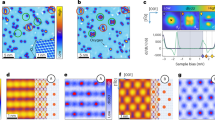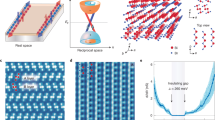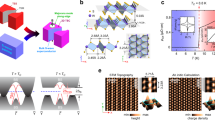Abstract
Topological superconductors are an essential component for topologically protected quantum computation and information processing. Although signatures of topological superconductivity have been reported in heterostructures, material realizations of intrinsic topological superconductors are rather rare. Here we use scanning tunnelling spectroscopy to study the transition metal dichalcogenide 4Hb-TaS2 that interleaves superconducting 1H-TaS2 layers with strongly correlated 1T-TaS2 layers, and find spectroscopic evidence for the existence of topological surface superconductivity. These include edge modes running along the 1H-layer terminations as well as under the 1T-layer terminations, where they separate between superconducting regions of distinct topological nature. We also observe signatures of zero-bias states in vortex cores. All the boundary modes exhibit crystallographic anisotropy, which—together with a finite in-gap density of states throughout the 1H layers—allude to the presence of a topological nodal-point superconducting state. Our theoretical modelling attributes this phenomenology to an inter-orbital pairing channel that necessitates the combination of surface mirror symmetry breaking and strong interactions. It, thus, suggests a topological superconducting state realized in a natural compound.
This is a preview of subscription content, access via your institution
Access options
Access Nature and 54 other Nature Portfolio journals
Get Nature+, our best-value online-access subscription
$29.99 / 30 days
cancel any time
Subscribe to this journal
Receive 12 print issues and online access
$209.00 per year
only $17.42 per issue
Buy this article
- Purchase on Springer Link
- Instant access to full article PDF
Prices may be subject to local taxes which are calculated during checkout




Similar content being viewed by others
Data availability
The data needed to reproduce the main text figures are available on Zenodo (https://doi.org/10.5281/zenodo.5229526).
Code availability
The codes used in theoretical simulations and calculations are available from the corresponding authors upon reasonable request.
References
Kitaev, A. Y. Fault-tolerant quantum computation by anyons. Ann. Phys. 303, 2–30 (2003).
Nayak, C., Simon, S. H., Stern, A., Freedman, M. & Das Sarma, S. Non-Abelian anyons and topological quantum computation. Rev. Mod. Phys. 80, 1083 (2008).
Lutchyn, R. M. et al. Majorana zero modes in superconductor–semiconductor heterostructures. Nat. Rev. Mater. 3, 52–68 (2018).
Nadj-Perge, S. et al. Observation of Majorana fermions in ferromagnetic atomic chains on a superconductor. Science 346, 602–607 (2014).
Jäck, B. et al. Observation of a Majorana zero mode in a topologically protected edge channel. Science 364, 1255–1259 (2019).
Fornieri, A. et al. Evidence of topological superconductivity in planar Josephson junctions. Nature 569, 89–92 (2019).
Ren, H. et al. Topological superconductivity in a phase-controlled Josephson junction. Nature 569, 93–98 (2019).
Yin, J.-X. et al. Observation of a robust zero-energy bound state in iron-based superconductor Fe(Te,Se). Nat. Phys. 11, 543–546 (2015).
Kong, L. et al. Half-integer level shift of vortex bound states in an iron-based superconductor. Nat. Phys. 15, 1181–1187 (2019).
Zhu, S. et al. Nearly quantized conductance plateau of vortex zero mode in an iron-based superconductor. Science 367, 189–192 (2019).
Liu, Q. et al. Robust and clean Majorana zero mode in the vortex core of high-temperature superconductor (Li0.84Fe0.16) OHFeSe. Phys. Rev. X 8, 041056 (2018).
Chen, C. et al. Atomic line defects and zero-energy end states in monolayer Fe(Te,Se) high-temperature superconductors. Nat. Phys. 16, 536–540 (2020).
Qi, X.-L. & Zhang, S.-C. Topological insulators and superconductors. Rev. Mod. Phys. 83, 1057 (2011).
Schnyder, A. P. & Brydon, P. M. R. Topological surface states in nodal superconductors. J. Phys. Condens. Matter 27, 243201 (2015).
Sato, M. & Ando, Y. Topological superconductors: a review. Rep. Prog. Phys. 80, 076501 (2017).
Ménard, G. C. et al. Two-dimensional topological superconductivity in Pb/Co/Si(111). Nat. Commun. 8, 2040 (2017).
Palacio-Morales, A. et al. Atomic-scale interface engineering of Majorana edge modes in a 2D magnet-superconductor hybrid system. Sci. Adv. 5, eaav6600 (2019).
Kezilebieke, S. et al. Topological superconductivity in a van der Waals heterostructure. Nature 588, 424–428 (2020).
Yuan, Y. et al. Evidence of anisotropic Majorana bound states in 2M-WS2. Nat. Phys. 15, 1046–1051 (2019).
Jiao, L. et al. Chiral superconductivity in heavy-fermion metal UTe2. Nature 579, 523–527 (2020).
Ye, J. T. et al. Superconducting dome in a gate-tuned band insulator. Science 338, 1193–1196 (2012).
Xi, X. et al. Ising pairing in superconducting NbSe2 atomic layers. Nat. Phys. 12, 139–143 (2016).
de la Barrera, S. C. et al. Tuning Ising superconductivity with layer and spin–orbit coupling in two-dimensional transition-metal dichalcogenides. Nat. Commun. 9, 1427 (2018).
Sajadi, E. et al. Gate-induced superconductivity in a monolayer topological insulator. Science 362, 922–925 (2018).
Fatemi, V. et al. Electrically tunable low-density superconductivity in a monolayer topological insulator. Science 362, 926–929 (2018).
Yuan, N. F., Mak, K. F. & Law, K. T. Possible topological superconducting phases of MoS2. Phys. Rev. Lett. 113, 097001 (2014).
Zhou, B. T., Yuan, N. F., Jiang, H. L. & Law, K. T. Ising superconductivity and Majorana fermions in transition-metal dichalcogenides. Phys. Rev. B 93, 180501 (2016).
Hsu, Y.-T., Vaezi, A., Fischer, M. H. & Kim, E.-A. Topological superconductivity in monolayer transition metal dichalcogenides. Nat. Commun. 8, 14985 (2017).
He, W.-Y. et al. Magnetic field driven nodal topological superconductivity in monolayer transition metal dichalcogenides. Commun. Phys. 1, 40 (2018).
Fischer, M. H., Sigrist, M. & Agterberg, D. F. Superconductivity without inversion and time-reversal symmetries. Phys. Rev. Lett. 121, 157003 (2018).
Hsu, Y. T., Cole, W. S., Zhang, R. X. & Sau, J. D. Inversion-protected higher-order topological superconductivity in monolayer WTe2. Phys. Rev. Lett. 125, 097001 (2020).
Kanasugi, S. & Yanase, Y. Multiple odd-parity superconducting phases in bilayer transition metal dichalcogenides. Phys. Rev. B 102, 094507 (2020).
Shaffer, D., Kang, J., Burnell, F. J. & Fernandes, R. M. Crystalline nodal topological superconductivity and Bogolyubov Fermi surfaces in monolayer NbSe2. Phys. Rev. B 101, 224503 (2020).
Margalit, G., Berg, E. & Oreg, Y. Theory of multi-orbital topological superconductivity in transition metal dichalcogenides. Ann. Phys. https://doi.org/10.1016/j.aop.2021.168561 (in the press).
Geim, A. K. & Grigorieva, I. V. Van der Waals heterostructures. Nature 499, 419–425 (2013).
Law, K. T. & Lee, P. A. 1T-TaS2 as a quantum spin liquid. Proc. Natl Acad. Sci. USA 114, 6996–7000 (2017).
Ribak, A. et al. Chiral superconductivity in the alternate stacking compound 4Hb-TaS2. Sci. Adv. 6, eaax9480 (2020).
Gao, Y., Su, W.-P. & Zhu, J.-X. Interorbital pairing and its physical consequences for iron pnictide superconductors. Phys. Rev. B 81, 104504 (2010).
Wang, F. & Lee, D.-H. Topological relation between bulk gap nodes and surface bound states: application to iron-based superconductors. Phys. Rev. B 86, 094512 (2012).
Fukaya, Y. et al. Interorbital topological superconductivity in spin-orbit coupled superconductors with inversion symmetry breaking. Phys. Rev. B 97, 174522 (2018).
Di Salvo, F. J., Bagley, B. G., Voorhoeve, J. M. & Waszczak, J. V. Preparation and properties of a new polytype of tantalum disulfide (4Hb-TaS2). J. Phys. Chem. Solids 34, 1357–1362 (1973).
Tanaka, M. et al. Study of 4Hb-TaS2 and graphite intercalation compound by STM/STS. J. Microsc. 152, 183–192 (1988).
Kim, J. J. & Olin, H. Atomic- and electronic-structure study on the layers of 4Hb-TaS2 prepared by a layer-by-layer etching technique. Phys. Rev. B 52, R14388(R) (1995).
Fujisawa, Y. et al. Superposition of \(\sqrt{13}\times \sqrt{13}\) and 3 × 3 supermodulations in TaS2 probed by scanning tunneling microscopy. J. Phys. Conf. Ser. 969, 012053 (2018).
Wijayaratne, K. et al. Spectroscopic signature of moment-dependent electron–phonon coupling in 2H-TaS2. J. Mater. Chem. C 5, 11310 (2017).
Reiner, J. et al. Spectroscopic visualization of a robust electronic response of semiconducting nanowires to deposition of superconducting islands. Phys. Rev. X 10, 011002 (2020).
Hess, H. F., Robinson, R. B., Dynes, R. C., Valles, J. M. & Waszczak, J. V. Scanning-tunneling-microscope observation of the Abrikosov flux lattice and the density of states near and inside a fluxoid. Phys. Rev. Lett. 62, 214 (1989).
Möckli, D. & Khodas, M. Robust parity-mixed superconductivity in disordered monolayer transition metal dichalcogenides. Phys. Rev. B 98, 144518 (2018).
Perdew, J. P., Burke, K. & Ernzerhof, M. Generalized gradient approximation made simple. Phys. Rev. Lett. 77, 3865 (1996).
Kresse, G. & Joubert, D. From ultrasoft pseudopotentials to the projector augmented-wave method. Phys. Rev. B 59, 1758 (1999).
Grimme, S. Semiempirical GGA-type density functional constructed with a long-range dispersion correction. J. Comput. Chem. 27, 1787–1799 (2006).
Acknowledgements
N.A., H.B. and B.Y acknowledge the German-Israeli Foundation for Scientific Research and Development (GIF grant no. I-1364-303.7/2016). H.B. and N.A. acknowledge the European Research Council (ERC, project no. TOPO NW). B.Y. acknowledges financial support by the European Research Council (ERC Consolidator Grant, no. 815869), the Israel Science Foundation (ISF nos. 1251/19, 3520/20 and 2932/21) and the Willner Family Leadership Institute for the Weizmann Institute of Science, the Benoziyo Endowment Fund for the Advancement of Science, the Ruth and Herman Albert Scholars Program for New Scientists, and the Israel Science Foundation (ISF 1251/19). G.A.F. gratefully acknowledges partial support from the National Science Foundation through NSF grant nos. DMR-1720595 and DMR-1949701. Y.O. acknowledges partial support through the ERC under the European Union’s Horizon 2020 research and innovation programme (grant agreement LEGOTOP no. 788715), the ISF Quantum Science and Technology (2074/19), the BSF and NSF (2018643), and the CRC/Transregio 183. A.K. acknowledges the Israel Science Foundation (ISF 320/17).
Author information
Authors and Affiliations
Contributions
A.K.N., A.S. and Y.R. acquired and analysed the data. A.K., N.A. and H.B. conceived the experiments. J.K. and B.Y. calculated the ab initio model. G.M., G.A.F., B.Y. and Y.O. calculated the theoretical model. I.F., A.A. and A.K. grew the material. A.K.N., N.A. and H.B. wrote the manuscript with substantial contributions from all the authors.
Corresponding authors
Ethics declarations
Competing interests
The authors declare no competing interests.
Additional information
Peer review information Nature Physics thanks the anonymous reviewer for their contribution to the peer review of this work
Publisher’s note Springer Nature remains neutral with regard to jurisdictional claims in published maps and institutional affiliations.
Supplementary information
Supplementary Information
Supplementary Figs. 1–28 and Sections 1–14.
Rights and permissions
About this article
Cite this article
Nayak, A.K., Steinbok, A., Roet, Y. et al. Evidence of topological boundary modes with topological nodal-point superconductivity. Nat. Phys. 17, 1413–1419 (2021). https://doi.org/10.1038/s41567-021-01376-z
Received:
Accepted:
Published:
Issue Date:
DOI: https://doi.org/10.1038/s41567-021-01376-z
This article is cited by
-
Heavy fermions vs doped Mott physics in heterogeneous Ta-dichalcogenide bilayers
Nature Communications (2024)
-
Charge transfer and spin-valley locking in 4Hb-TaS2
npj Quantum Materials (2024)
-
Flat bands, strange metals and the Kondo effect
Nature Reviews Materials (2024)
-
Quantum spin liquid signatures in monolayer 1T-NbSe2
Nature Communications (2024)
-
Two-component nematic superconductivity in 4Hb-TaS2
Nature Communications (2024)



